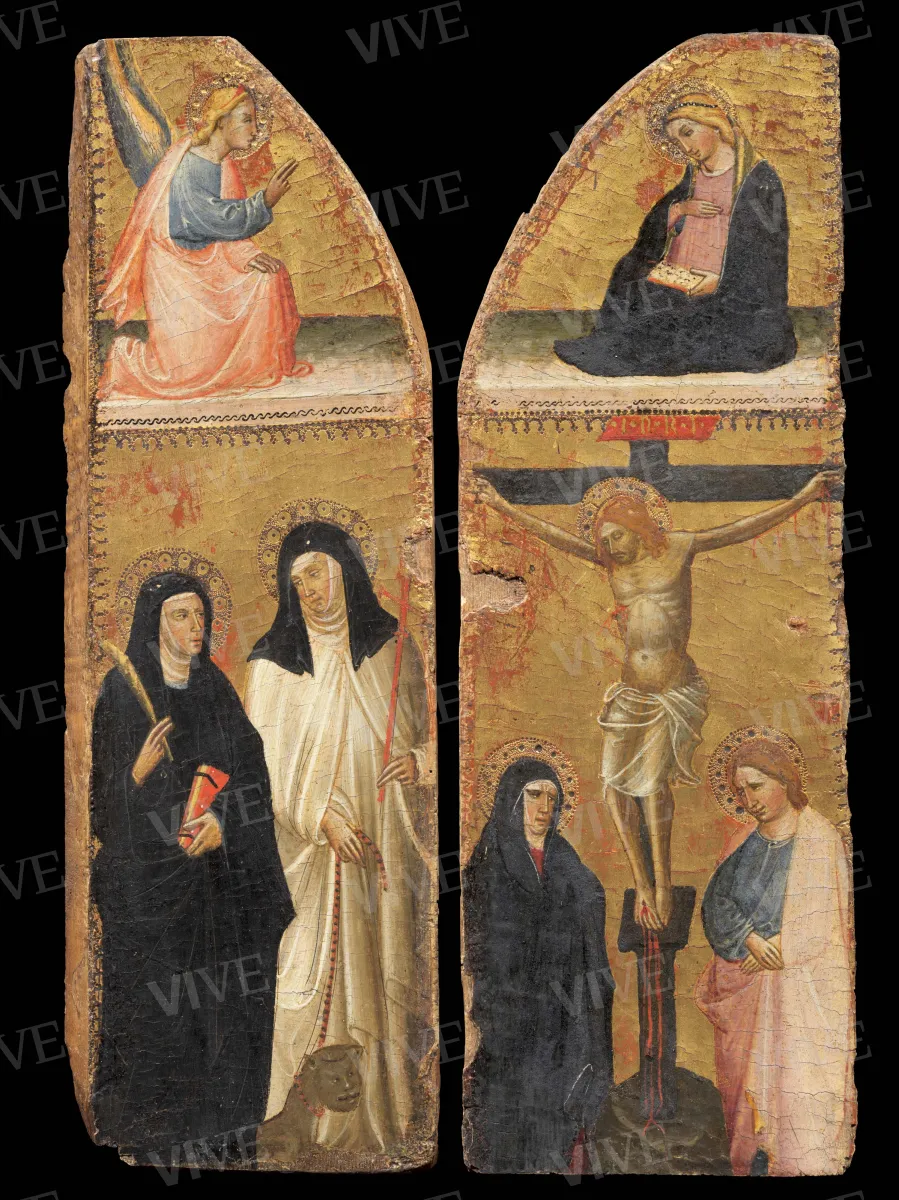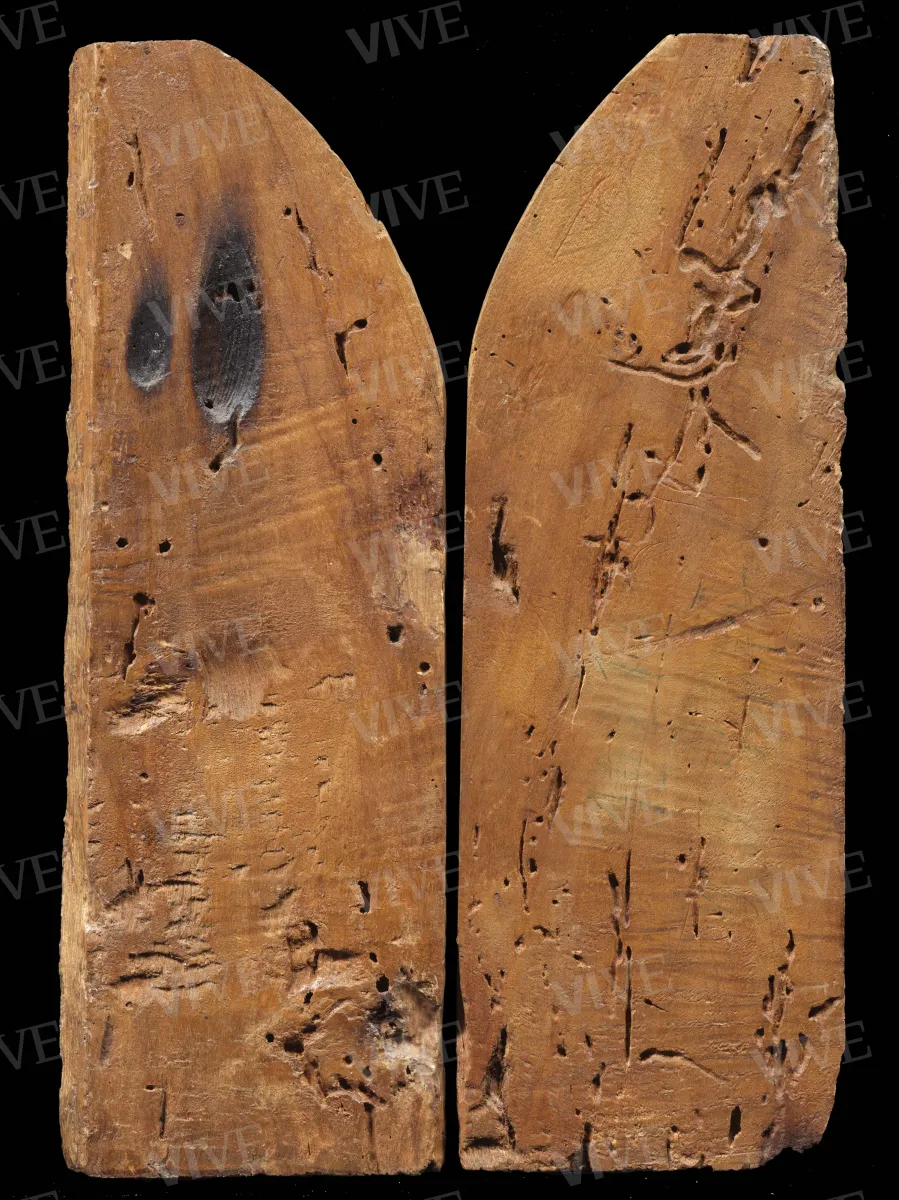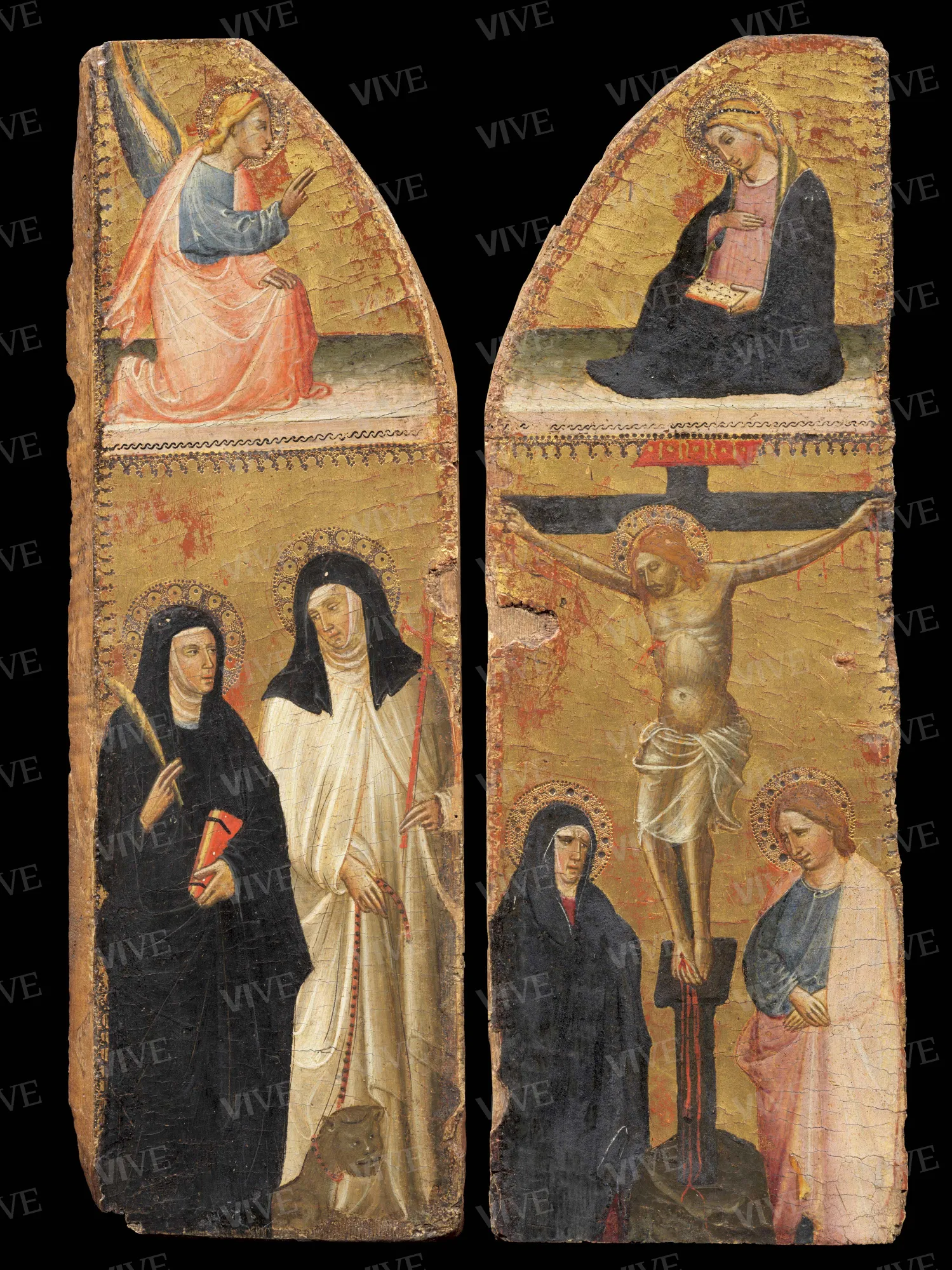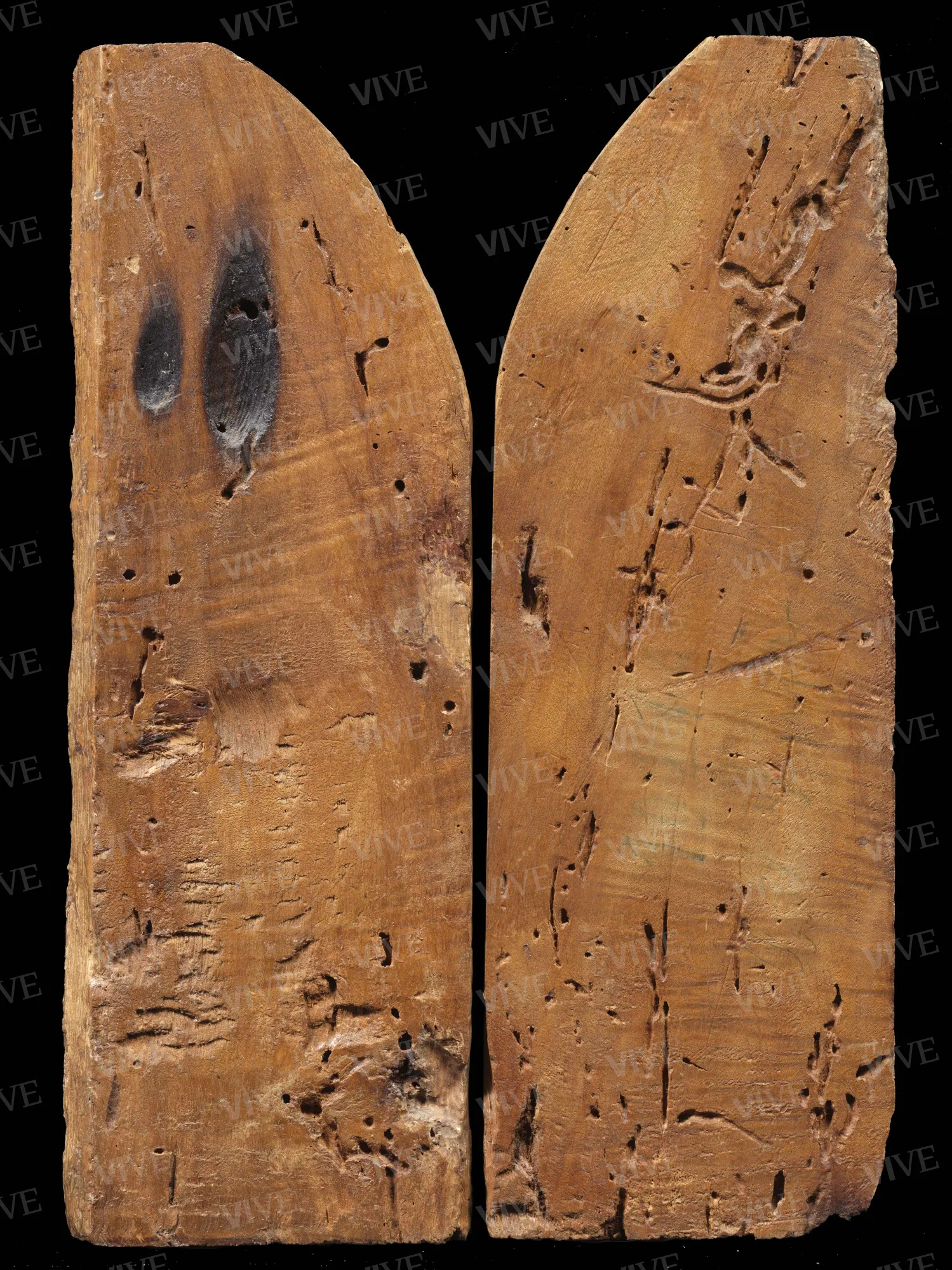Annunciation, Two Nun Saints and Crucifixion with Mourners
Master of San Jacopo a Mucciana C. 1415
The panel, originally part of a diptych intended for private devotion, is divided into two registers: in the center, a small twisted column divides the composition vertically; further segmentation is achieved horizontally via granite arches on a gold background. The upper register is entirely devoted to an Annunciation scene, while the lower register features, on the left, two nun saints of uncertain identification, one holding a processional cross and accompanied by a lion, and on the right a Crucifixion with Christ flanked by the Virgin and John the Evangelist. The work is attributed to the Master of San Jacopo a Mucciana, active in the Florentine area between the fourteenth and fifteenth centuries.
The panel, originally part of a diptych intended for private devotion, is divided into two registers: in the center, a small twisted column divides the composition vertically; further segmentation is achieved horizontally via granite arches on a gold background. The upper register is entirely devoted to an Annunciation scene, while the lower register features, on the left, two nun saints of uncertain identification, one holding a processional cross and accompanied by a lion, and on the right a Crucifixion with Christ flanked by the Virgin and John the Evangelist. The work is attributed to the Master of San Jacopo a Mucciana, active in the Florentine area between the fourteenth and fifteenth centuries.
Details of work
Catalog entry
This painting was transferred to Palazzo Venezia in 1940, following a notable donation to the state by the Roman banker Giovanni Armenise, who had previously acquired part of Giulio Sterbini’s collection. The panel, which is now stored in the Museum’s storerooms, has not received significant attention, and its attribution to the anonymous Master of San Jacopo a Mucciana is now widely accepted by critics.
In 1947, Antonino Santangelo assigned the work to a painter “comparable to the early period of Giovanni del Ponte” based on an indication by Roberto Longhi. Santangelo noted that it was a workshop product but also identified Pisan characteristics (Santangelo 1947, p. 39). Initially, Federico Zeri assigned the diptych to an anonymous Florentine painter, suggesting a date around 1415, in his brief entry in the Catalogo del Gabinetto Fotografico Nazionale (Zeri 1955, p. 9, no. 138). However, the definitive attribution of the panel to the Master of San Jacopo a Mucciana was made by Zeri himself in a subsequent article published in 1963. In this article, he reviewed the exhibition Arte in Valdelsa held that year at the Palazzo Pretorio in Certaldo (Zeri 1963, p. 263, note 6).
Richard Offner first identified a group of works attributable to the anonymous Master of San Jacopo a Mucciana (Offner 1946), whose principal piece is a triptych currently located in the San Casciano Val di Pesa Museo d’Arte Sacra, originally from the church of San Jacopo in Mucciana. This painting serves as the central element around which the painter’s catalogue has been progressively compiled. Notably, restoration work in 1988 revealed an inscription dating the work to January 1, 1398 (Proto Pisani 1992, pp. 31–32), making it the painter’s only definitive chronological reference.
Building on Offner’s initial collection of works, significant contributions to the painter’s catalogue have also been made by Zeri (1963), Miklós Boskovits (1975, p. 126, note 164), and more recently Andrea De Marchi. De Marchi attributed two panels depicting a Crucifixion and a Saint James the Greater and Saint Anthony, previously part of the Sestieri collection and appearing in a Finarte auction on September 29, 2009, to this painter. These panels were earlier assigned to the “school of Agnolo Gaddi” by Roberto Longhi in a 1962 expert opinion (Finarte auction report for lot 201).
The painter, described as a “pupil of the last Gaddi” (Zeri 1963, p. 247), embodies the cultural ambient of small Florentine workshops operating between the fourteenth and fifteenth centuries. According to Boskovits (1975, p. 126), these workshops were dedicated to “meeting the daily demands of the art market through” the artisanal reproduction of existing models and compositional schemes.
Fabio Mari
Entry published on 27 March 2025
State of conservation
Fair. Some color fading.
Provenance
Rome, Collezione Giulio Sterbini;
Rome, Collezione Giovanni Armenise;
Rome, storerooms of the Museo Nazionale di Palazzo Venezia from 1940.
References
Borenius Tancred, A little known collection at Oxford, in «The Burlington Magazine», XXVII, 145, 1915, pp. 21-27, 72-77;
Offner Richard, English Furniture, Modern Paintings and Old Masters, Early American Silver, Bronzes, Chinese Art, Rugs, Property of Henry P. McIlhenny and Mrs. John Wintersteen, Parke-Bernet Galleries, 5-7 giugno 1946;
Santangelo Antonino (a cura di), Museo di Palazzo Venezia. Catalogo. 1. Dipinti, Roma 1947;
Zeri Federico (a cura di), Catalogo del Gabinetto Fotografico Nazionale. 3. I dipinti del Museo di Palazzo Venezia in Roma, 3, Roma 1955;
Zeri Federico, La mostra “Arte in Valdelsa” a Certaldo, in «Bollettino d'arte», XLVIII, 3, 1963, pp. 245-25;
Boskovits Miklós, Pittura fiorentina alla vigilia del Rinascimento 1370-1400, Firenze 1975;
Proto Pisani Rosanna Caterina, Il Museo di Arte Sacra a San Casciano in Val di Pesa, Firenze 1992;
Labriola Ada, scheda n. 26 (Maestro di San Jacopo a Mucciana, Crocifissione), in Boskovits Miklós, Parenti Daniela (a cura di), Da Bernardo Daddi a Beato Angelico, a Botticelli. Dipinti fiorentini del Lindenau Museum di Altenburg, catalogo della mostra (Firenze, Museo di San Marco, 22 marzo-4 giugno 2005), Firenze 2005, pp. 122-124;
Laclotte Michelle, Moench Esther, Peinture italienne. Musée du Petit Palais, Avignon, Paris 2005;
De Marchi, Andrea, in Arredi e dipinti antichi dal XIV al XIX secolo. Una collezione di avori; una collezione di maioliche del XVI secolo; una collezione di dipinti antichi da una eredità bresciana, catalogo Finarte, 29 settembre 2009, p. 95, n. 201.














